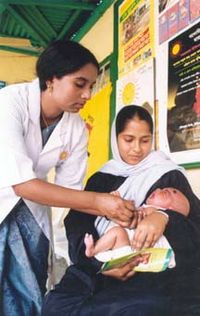
Photo from wikipedia
The prognosis of patients after acute coronary syndromes is still suboptimal, mainly due to the risk of recurrent adverse coronary events, which is greatest during the first year, but persists… Click to show full abstract
The prognosis of patients after acute coronary syndromes is still suboptimal, mainly due to the risk of recurrent adverse coronary events, which is greatest during the first year, but persists over one’s lifetime. Meaningful progress in preventing cardiovascular events has been achieved. However, there remains much room for improvement by embracing innovative therapies and investing in multidisciplinary approaches. Pharmacological interventions focused on optimising antithrombotic and lipid-lowering therapies are both pillars of secondary prevention that have seen recent ground-breaking advances. Moreover, new approaches in diabetic patients with cardiovascular disease and new targets for anti-inflammatory treatment may significantly improve prevention strategies in the future. However, pharmacological treatments are expensive and can have significant side effects. Developing better tools in order to identify high-risk patients and promote more personalised strategies for each patient should be an absolute priority. Furthermore, adherence to medication is still low and represents a real challenge; several strategies to improve low adherence to treatment are currently under discussion. Non-pharmacological interventions are also essential. Improving communication with patients and advanced surveillance for those secondary risk factors that may negatively impact prognosis are crucial. Encouraging multidisciplinary teams that work effectively to optimise all aspects of secondary prevention, including a cardiac rehabilitation programme, is the optimal approach. Current secondary prevention strategies and suggestions for areas of improvement are discussed in this manuscript. However, the question remains: will research in secondary prevention continue to focus on stronger and more expensive drugs, or is it time for us to embrace a more patient-centred clinical and research model?
Journal Title: European Journal of Preventive Cardiology
Year Published: 2017
Link to full text (if available)
Share on Social Media: Sign Up to like & get
recommendations!